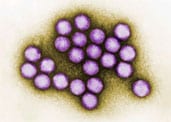At a glance
- Adenoviruses are common viruses that cause mild cold- or flu-like illness.
- Adenoviruses can cause illness in people of all ages any time of year.
- People with weakened immune systems (including from medications they are taking or from heart or lung diseases) are at higher risk for developing severe adenovirus infection.

Clinician guidelines
Get clinical guidance for adenovirus Nucleic Acid Amplification Tests (NAATs), including PCR, and possible additional testing.
Clinical features
Adenoviruses most commonly cause respiratory illness. The illnesses can range from the common cold to pneumonia, croup, and bronchitis. Depending on the type, adenoviruses can cause other illnesses such as gastroenteritis, conjunctivitis, cystitis, and, less commonly, neurological disease.
Prevention
To prevent healthcare-associated outbreaks of adenovirus infections, health care providers should strictly follow infection control practices, including
- contact and droplet precautions
- environmental cleaning with appropriate disinfectants
- prompt response and reporting of clusters of cases
For suspected cases of pneumonia caused by adenovirus infection, healthcare providers should follow the guidelines for preventing healthcare-associated pneumonia.
See Guideline for Isolation Precautions: Preventing Transmission of Infectious Agents in Healthcare Settings for more information.
Adenoviruses are resistant to many common disinfectants and can remain infectious for hours on environmental surfaces and medical instruments.
To prevent spread of adenoviruses, use an EPA-registered disinfectant on surfaces that is effective at killing adenoviruses and compatible with the surfaces and equipment.
Disinfectants effective against norovirus should also be effective against adenoviruses. See EPA List G for these disinfectants.
For more information on infection prevention and disinfection, see:
Testing and diagnosis
Health professionals should:
- Consider adenoviruses as possible causes of upper respiratory infection, lower respiratory infection (such as pneumonia), conjunctivitis (individual cases or outbreaks), and gastroenteritis.
- Report clusters of possible adenovirus infections (e.g., respiratory infections, conjunctivitis) to the state or local health department.
Methods for testing and typing:
- Adenovirus infections can be identified in the clinical setting using antigen detection or polymerase chain reaction (PCR) testing.
- Adenovirus PCR testing is most commonly accessible to clinicians by using a multipathogen PCR test (i.e., a PCR test that can test a single respiratory or stool specimen for adenovirus and many other common respiratory or enteric pathogens).
- Virus culture can also be used to diagnose adenovirus infections, but these tests are typically reserved for epidemiologic investigations and are less commonly used in clinical settings.
- Adenovirus (geno)typing is possible and usually done by molecular methods (i.e., full or partial genomic sequencing).
- Adenovirus PCR testing is most commonly accessible to clinicians by using a multipathogen PCR test (i.e., a PCR test that can test a single respiratory or stool specimen for adenovirus and many other common respiratory or enteric pathogens).
Treatment and recovery
There is no specific treatment for people with adenovirus infection. Most adenovirus infections are mild and do not require any medical care.
Clinical care of adenovirus infections includes treatment of symptoms and complications. There are no FDA-approved antiviral drugs for adenovirus treatment. For hospitalized people with severe adenovirus infection, consultation with infectious disease experts is recommended.
Risk
People with weakened immune systems are at high risk for developing severe illness caused by adenovirus infection. Some people infected with adenoviruses, especially those who have weakened immune systems, can have ongoing infections in their tonsils, adenoids, and intestines that do not cause symptoms. They can shed the virus for weeks or longer.
Resources
CDC. Adenovirus-associated epidemic keratoconjunctivitis outbreaks — four states, 2008–2010.MMWR. 2013;62(32);637-41.
